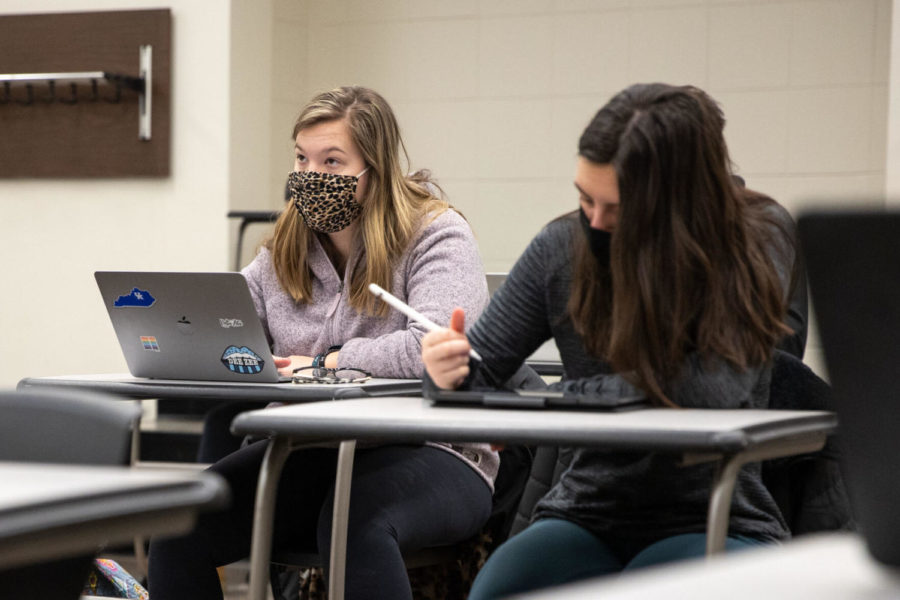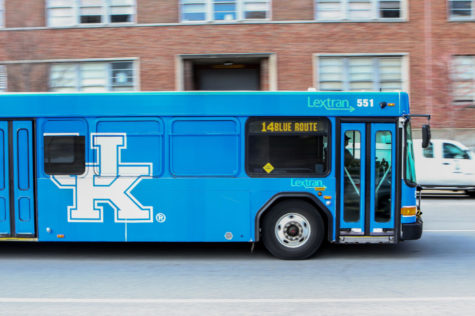Modality numbers alter little from spring
February 8, 2021
Spring 2021 is the third semester marked by COVID-19, and that means another semester of mixed course modalities.
Across the university this semester, 40 percent of course sections are traditional in-person instruction, 37 percent are online and 21 percent are hybrid – with a small 2 percent represented by modalities like off-campus and compressed video.
These numbers remained mainly the same as compared to last semester, with 2.8 percent more in-person sections, 5 percent fewer online sections, and 2 percent more hybrid sections.
“As in the fall, we’ve tried to offer as much in-person instruction for students as possible, understanding that both students and faculty are interested in a variety of modalities – from completely online to hybrid and traditional,” UK spokesperson Jay Blanton said.
Colleges and departments were the ultimate decider of course modality, with some guidance from the university.
“The University did encourage colleges and departments to offer courses with some level of face-to-face learning (Traditional or Hybrid modality), and also encouraged programs to be very intentional on student engagement in the courses, regardless of whether online or in modalities with face-to-face learning,” Blanton said.
Even under this guidance, Blanton said that no faculty member “has ever been asked or required to teach in a format with which they were uncomfortable.”
With more in-person sections this semester and the rise of the COVID-19 vaccine, a question arose of whether faculty members teaching in person would be first in line to get the vaccine when it started rolling out on campus. Blanton said that would depend on state guidelines.
“As we are able to vaccinate members of our campus community, we will – per the state’s guidelines – prioritize for factors such as age or, for example, whether someone is working on campus, whether that’s in-person instruction or custodial and dining workers or students working in residence halls,” Blanton said.
Blanton said that UK is confident that if all the recommended procedures are followed, in-person classes can be conducted safely as seen last semester.
“Where everyone complies with healthy behaviors – in terms of physical distancing, mask wearing and other behaviors – we can safely conduct in-person classes and continue a residential experience. Our students, faculty and staff did an incredible job last semester in complying with these essential health standards,” Blanton said.
Second-year early education major Rachel Donahue said she is also confident that her in-person classes are being conducted in a way that keeps her safe.
“I am comfortable taking in-person classes,” Donahue said. “My biggest class is like 20 people, and we have at least six seats in between us, so it’s perfect.”
Donahue, who has two in-person classes, said that having this small return to normalcy made her realize how much she missed being in the classroom.
“I will admit at first I wanted to be all online this semester, but after going to in-person classes, I realized how much I miss it,” Donahue said. “I miss going to class and truly focusing. I miss getting up and actually getting ready and going outside.”
Freshman pre-marketing major Caroline Yandell said she wasn’t as comfortable with in-person class yet.
“Honestly, I prefer online. I don’t actually prefer online in the sense of receiving my education, but being in person and having possible exposures makes me uncomfortable, “ Yandell said. However, Yandell does have a class that meets in-person once a week.
“The in-person class, though uncomfortable, gives me a stronger feeling of connection to the course and my classmates. That said, I am nervous about being in the classroom so I think one is enough,” Yandell said.
Some students actually prefer to have this mixed modality style of learning, like freshman philosophy and political science double major McKenzie Ryan.
“I like to mix online, hybrid and in person together, which I was able to do this semester,” Ryan said.
Due to a visual disability, Ryan said that she prefers synchronous online or hybrid classes that have recordings to watch afterwards so that she can refer back to the material and take notes at her own speed.
Ryan said that because of this she would like to see more of her upper level courses continue to be offered as an online option in the future. Ryan, who has two in-person classes, said, however, that this doesn’t mean she doesn’t enjoy or feel comfortable with in-person classes.
“I don’t feel more or less comfortable with in-person class. They’ve done an excellent job with social distancing, so I don’t feel like I’m ever in a dangerous situation,” Ryan said.
Regan Denham, first-year human health sciences major, said she feels more comfortable with in-person classes this semester than she did last year, but that’s not because of any extra precautions taken by the school.
“I somehow got COVID even though I never went out anywhere. Because I already had it, I feel fine to attend class since reinfection rates are very low overall,” Denham said.
Denham said she prefers in-person classes over other course modalities, but she has six online and two hybrid courses. Denham said online instruction limits her resources and motivation that she needs to complete her work.
“The struggle I face when not having in person is the motivation to complete online work and, some days, even the motivation to get out of bed. Staring at a computer screen all day isn’t healthy for the mind or body,” Denham said.
Denham said she would like to see more hybrid courses
within her major, so she can have at least some portion of in-person instruction. “My major is pretty small, so my class sizes usually range in the 20s. I don’t see why we couldn’t meet in-person when I have yet to see a large lecture hall used this school year,” Denham said.
“There is definitely space to accommodate more hybrid classes this semester, but the effort is not being put forth to do so.”
Overall, the university has increased course sections offered in hybrid modality by 2 percent this semester as compared to last semester.




















































































































































